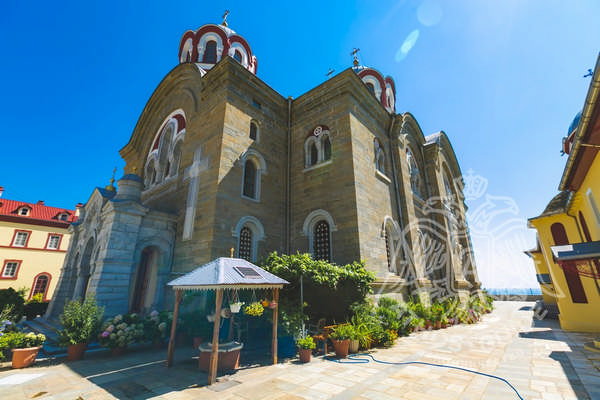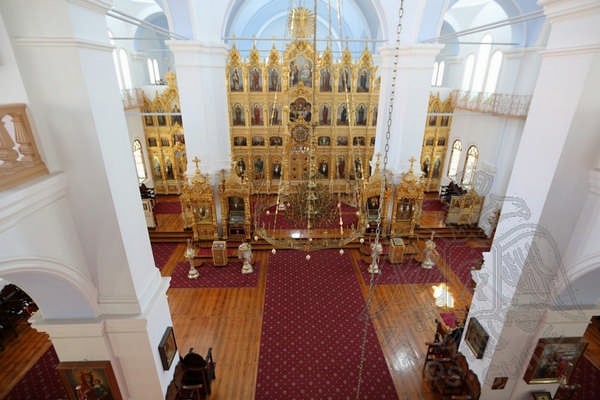History and present days
.jpg) From the carriage road or the cobbled path one reaches the Skete of the Prophet Elijah, which dominates the slope with its huge and massive cistern. It was originally a cell of the Monastery of Pantokrator. In 1757 it was granted to the Ukrainian-Moldavian monk Osios Paisios Velichkovsky. It was recognized in 1839 as a communal Russian-speaking skete. Its rapid building and population growth led to arguments with the Pantokrator Monastery, which feared the possibility of the Russian-speaking cenobitic sketes becoming monasteries. The disagreement led to lawsuits in secular courts and a compromise was reached only in 1892, with a patriarchal decision defining the relations between the two foundations. On 22.7.1881 the yacht "Ereklik" of the Grand Duchess Alexandra Petrovna anchored off the coast, while she was watching from the deck the progress of the works that were made in the skete. By her order, Vice Admiral Dmitry Golobatsov laid the foundation stone of the kyriakon, without the presence of a high priest. This irregular action further aggravated the strained relations between the monastery and the skete.
From the carriage road or the cobbled path one reaches the Skete of the Prophet Elijah, which dominates the slope with its huge and massive cistern. It was originally a cell of the Monastery of Pantokrator. In 1757 it was granted to the Ukrainian-Moldavian monk Osios Paisios Velichkovsky. It was recognized in 1839 as a communal Russian-speaking skete. Its rapid building and population growth led to arguments with the Pantokrator Monastery, which feared the possibility of the Russian-speaking cenobitic sketes becoming monasteries. The disagreement led to lawsuits in secular courts and a compromise was reached only in 1892, with a patriarchal decision defining the relations between the two foundations. On 22.7.1881 the yacht "Ereklik" of the Grand Duchess Alexandra Petrovna anchored off the coast, while she was watching from the deck the progress of the works that were made in the skete. By her order, Vice Admiral Dmitry Golobatsov laid the foundation stone of the kyriakon, without the presence of a high priest. This irregular action further aggravated the strained relations between the monastery and the skete.
Its rapid growth in terms of buildings and population (at the beginning of the 20th century it had about 300 monks) was followed by a period of gradual desolation after the October Revolution (1917). In 1992 it was manned by Greek monks, who had previously been monks in the Xenophontos Skete of the Annunciation of the Virgin Mary.

 The skete has a rectangular structure. The wings around the magnificent and imposing kyriakon, house chapels, a trapeza, a kitchen, an arhontariki, the apartment of the head of the skete, monks' cells and an hagiographic workshop. The old hospital was converted into a guest house. Outside the north wing there is a well-preserved windmill. The whole building complex was completed between 1839-1903 and rests on a huge built-up terrace. In the underground spaces, the huge stone arches, that hold all the above-ground buildings together, are particularly impressive. An underground vaulted conduit leads to the sea. The main gate is in the west wing, under the bell tower. The west and east wings are the oldest.
The skete has a rectangular structure. The wings around the magnificent and imposing kyriakon, house chapels, a trapeza, a kitchen, an arhontariki, the apartment of the head of the skete, monks' cells and an hagiographic workshop. The old hospital was converted into a guest house. Outside the north wing there is a well-preserved windmill. The whole building complex was completed between 1839-1903 and rests on a huge built-up terrace. In the underground spaces, the huge stone arches, that hold all the above-ground buildings together, are particularly impressive. An underground vaulted conduit leads to the sea. The main gate is in the west wing, under the bell tower. The west and east wings are the oldest. In the south wing there is the spacious chapel of Saint Mitrophanes and of the Holy Theopatores, Saint Joachim and Saint Anne (1840), with an eclectic iconostasis and Renaissance icons. On the ground floor of the north wing there is the chapel of Saint Nicholas. It is a basilica which served the congregation of the brotherhood while the main church was being built. In its gilded iconostasis, there is the icon of the Virgin Mary “Galaktotrophousa”, which means “Nursing”. Her shirt is made of pearls. In the southwest corner of the skete, on the first floor, there is the chapel of the Annunciation of the Virgin Mary (1761), built by Saint Paisios Velitskowski himself.
In the south wing there is the spacious chapel of Saint Mitrophanes and of the Holy Theopatores, Saint Joachim and Saint Anne (1840), with an eclectic iconostasis and Renaissance icons. On the ground floor of the north wing there is the chapel of Saint Nicholas. It is a basilica which served the congregation of the brotherhood while the main church was being built. In its gilded iconostasis, there is the icon of the Virgin Mary “Galaktotrophousa”, which means “Nursing”. Her shirt is made of pearls. In the southwest corner of the skete, on the first floor, there is the chapel of the Annunciation of the Virgin Mary (1761), built by Saint Paisios Velitskowski himself.



